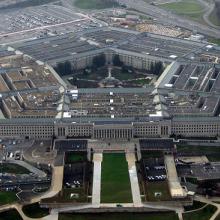al-Qaida
In the aftermath of a Oct. 14 truck bombing that killed over 300 people in Mogadishu, Somalia, thousands of people took to the capital's streets in response to mayor Thabit Abdi's call to unity, according to The Guardian.
An internationally renowned atheist activist has relocated from India to the U.S. after receiving death threats from an extremist group that has claimed responsibility for at least one of three machete killings of South Asian atheists this year.
Taslima Nasrin, a Bangladeshi gynecologist, novelist, and poet, arrived in New York state on May 27. The move was orchestrated by the Center for Inquiry, an organization that promotes secularism and has been working with atheist activists in countries where atheism is unprotected by blasphemy laws.
The arrests of six Minnesota men accused earlier this month of attempting to join the Islamic State group highlights an unprecedented marketing effort being waged by the militant group in Iraq and Syria, U.S. law enforcement officials and terror analysts said.
It’s a campaign that is finding resonance from urban metros to the American heartland.
“This is not so much a recruitment effort as it is a global marketing campaign, beyond anything that al-Qaida has ever done,” said a senior law enforcement official.
The official, who is not authorized to comment publicly, said the Islamic State’s slick multimedia productions, its use of social media, and personal “peer-to-peer” communication are proving to be effective parts of a sophisticated program aimed at the West.
“I don’t think there has been one case in which we haven’t found some connection to the videos or other media the group has produced,” the official said.
Federal authorities have identified more than 150 U.S. residents who have sought to join the ranks of the terror organization or rival groups in Syria. There is evidence that about 40 of those have traveled to the region and returned to the U.S. Most have been charged; an undisclosed number are free and subjects of intense surveillance, the senior official said.
The smallest subset of the group, an estimated dozen, represents those who have actually joined the fighting ranks.
Sitting under a veranda at the former headquarters of Somali Airlines, Ali Bashir sipped coffee and chewed khat, an African herb, as he recounted 15 years of anarchy fomented by al-Shabab Islamic terrorists.
“Life is very hard here,” he lamented.
“There’s nothing to eat and nowhere to work. But the rebels will come and still ask you for money.”
Since Somalia’s central government collapsed in the early 1990s, al-Shabab has emerged as the greatest threat to international efforts to rebuild the east African nation. The al-Qaida-linked militants extort, kidnap, stage terror attacks, and control remote areas of the countryside.
Al-Shabab gained renewed global attention last week, when a small band of militants massacred 148 people at Garissa University College in neighboring Kenya, where they singled out Christians for execution. In 2013, al-Shabab terrorists attacked the Westgate Mall in Nairobi, Kenya, murdering nearly 70.
In the wake of this month’s attack, Somalia President Hassan Sheikh Mohamud called for more cooperation between Kenya and Somalia to eliminate al-Shabab, and Kenyan jets pounded two al-Shabab camps in Somalia.
Bashir, 28, who sold clothing before fleeing here, doubted the Somali government could do much about the terrorist group. He fled to the capital here a few years ago after al-Shabab seized control of a region in the south. He now lives in the old airlines headquarters with 1,000 other families.
“I have grown up in this country without knowing peace or stability,” said Bashir, a father of six.
Is the Islamic State — ISIS or ISIL — different from other Islamist terror groups? If so, is the difference one of substance or simply degree? Or is there any real difference at all?
The question preoccupies the best intelligence professionals and academic students of the Arab Muslim world, but so far has produced more confusion than certainty about what we’re witnessing.
Maybe we’re too close. Maybe we’d gain perspective by going back in time — to 1993, say, and an article by a Harvard history professor, Samuel Huntington, in the magazine Foreign Affairs and later in a book titled The Clash of Civilizations.
Huntington saw a grim future and a different kind of war. While nation-states remain principal players in world affairs, he wrote, the great conflicts of the future will be between “different civilizations.”
“The clash of civilizations will dominate global politics,” he wrote. “The fault lines between civilizations will be the battle lines of the future.”
The Pentagon on Sept. 5 confirmed that the leader of al-Shabab, an al-Qaida-linked organization in Africa, was killed in a U.S. airstrike in Somalia this week.
The leader, Ahmed Abdi Godane, was targeted Sept. 1 in an airstrike that hit a vehicle and compound in a militant stronghold south of the capital, Mogadishu.
Al-Shabab has been linked to a number of attacks in Africa, including the bloody siege at the upscale Westgate Mall in Nairobi, Kenya, in September 2013 that killed 67 people.
“Removing Godane from the battlefield is a major symbolic and operational loss to al-Shabab,” Pentagon Press Secretary Rear Admiral John Kirby said in a statement.
At the time of the strike, the Pentagon said it could not confirm Godane’s death.
On May 21, the National September 11 Memorial and Museum in New York is scheduled to release “The Rise of Al Qaeda,” a seven-minute film telling the story of the attacks. Full disclosure: I have not watched the film.
Here’s why the 9/11 museum should drop these terms from the film.
A prominent Italian Jesuit who is an outspoken supporter of the uprising against Syrian President Bashar al-Assad went missing in Syria Monday, fueling speculation that he has been kidnapped by an Islamist group.
The Rev. Paolo Dall’Oglio, 58, lived for three decades in Syria, where he established an ecumenical community at Mar Musa on the site of an early Christian monastery, engaging in interfaith dialogue with Muslims and forging close ties with the local population.
He was expelled in 2012 by the Assad government for his support of the rebels.







